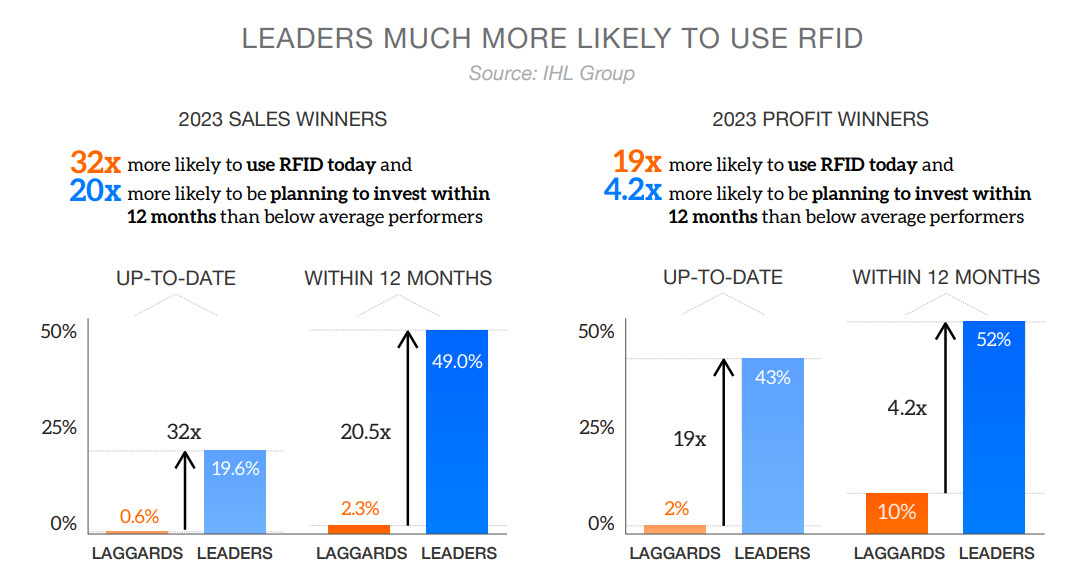RFID’s Striking Impact on Sales and Profits

We (IHL Group) recently released new research that sheds light on an old technology. After interviewing 209 major brands post pandemic, RFID is showing a massive impact on the financial strength of retailers. Supporting the traditional walk-in client as well as becoming crucial for BOPIS, Ship from Store, or Local Delivery from store, this technology decades old not only has new life but has proven to be a key differentiator.
RFID is a technology that uses radio waves to identify and track objects. RFID tags, which can be attached to products, assets, or people, contain a microchip and an antenna that store and transmit data. RFID readers, which can be handheld or fixed, scan the tags and communicate with a central database or cloud service. RFID technology enables retailers to achieve real-time inventory visibility, accuracy, and management, as well as to streamline their supply chain, logistics, and fulfillment processes. RFID can also be used to enhance customer service, loyalty, and engagement by enabling faster checkout, self-service, personalized recommendations, and interactive experiences. It’s a technology first used in retail over 20 years ago but was actually originally invented in the 1940s!
The Impact of RFID Technology on Retail Performance
According to the IHL research paper, RFID technology has a significant impact on the financial performance and market positioning of retailers. The paper defines the leading retailers as those with 10% or higher sales or profit growth, and the below average retailers as those with flat to negative sales or profit growth. Some of the key findings from the paper are summarized below.
- The 2023 sales winners, (2023 sales growth > 10%), are 32x more likely to be already using RFID technology than below average retailers, and 20.5x more likely to be planning to deploy RFID technology within 12 months.
- The 2023 profit winners (2023 profit growth > 10%) are 19x more likely to be up-to-date on deployment of RFID technology than below average retailers and are deploying RFID technology at a rate 4.2x higher within 12 months than below average retailers.
- Companies that are already using RFID technology in the study averaged profit growth in 2023 that was 57% higher than those who do not, and they are expecting their profits in 2024 to be 88% higher than those not already using RFID.
- The leading retailers are prioritizing RFID at a rate 333% higher in the next two years than the below average retailers.
These findings demonstrate the significant value and potential of RFID for retailers, especially in the context of the increasing digitalization and omnichannel transformation of the retail industry. RFID technology can not only improve the efficiency and effectiveness of existing processes and functions, but also enable new capabilities and opportunities for differentiation and growth. The leading retailers are already leveraging RFID technology to gain a competitive edge and achieve superior performance, while the below average retailers are lagging and risking obsolescence.
The Synergy of RFID Technology and Other Technologies
RFID technology is not a standalone technology, but rather a part of a larger ecosystem that includes other technologies that can complement and augment each other, creating synergies and enabling new possibilities for retail innovation. Some of the technologies that can work together with RFID technology are:
- Computer vision
- Edge computing
- Merchandising/Inventory/Supply Chain solutions
- POS and Self-checkout
- Loss Prevention systems
- Artificial intelligence and machine learning
By combining these technologies, retailers can create a synergistic ecosystem that can support various aspects of retail operations, from demand planning and order fulfillment, to merchandising and loss prevention, to customer engagement and service. Some emerging solutions combine these technologies such as:
- Smart shelves
- Smart carts
- Smart mirrors
- Smart fitting rooms
- Enhanced Self-checkout
These are just some of the examples of how RFID technology can work together with other technologies to create a synergistic ecosystem that can support various aspects of retail operations. There are many more possibilities and opportunities for innovation and differentiation that retailers can explore and experiment with.
Final Thoughts
RFID technology is decades-old technology that is now an overnight success. But the data is clear. The adoption of RFID technology and other related technologies has a significant impact on the financial performance and market positioning of retailers.
For more information and charts, download “Retail’s Hidden Advantage: How RFID and Computer Vision Radically Improves Operational Performance.”